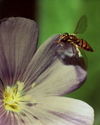Knowledge fuels change
For over a decade, Energypedia has shared free, reliable energy expertise with the world.
We’re now facing a serious funding gap.
Help keep this platform alive — your donation, big or small, truly matters!
Thank you for your support
Beneficial Plants (PA Technology)
| Name of technology example: | Type | |
| Beneficial Plants | ☐ Energy Efficiency ☐ Renewable Energy ☑ Alternative Methodology | |
| Description | A beneficial weed is any of various plants not generally considered domesticated, but which nonetheless has some companion plant effect, or else is edible or somehow beneficial. Beneficial weeds include a great many wildflowers, as well as other weeds that are commonly removed or poisoned.
(Source: http://en.wikipedia.org/wiki/Beneficial_weed) Beneficial weeds can accomplish a number of roles in the garden or yard, including fertilizing the soil, increasing moisture, acting as shelter or living mulch, repelling pests, attracting beneficial insects, or serving as food or other resources for human beings. Source: http://en.wikipedia.org/wiki/List_of_beneficial_weeds) Companion planting in gardening and agriculture is the planting of different crops in proximity for pest control, pollination, providing habitat for beneficial creatures, maximizing use of space and to otherwise increase crop productivity. Companion planting is a form of polyculture. Companion planting is used by farmers and gardeners in both industrialized and developing countries for many reasons. (Source: http://en.wikipedia.org/wiki/Companion_planting) | ||||||||||||||||||||||||||||
| Technology for the Application of |
| ||||||||||||||||||||||||||||
| Primarily Relevant for the following Agricultural Value Chain Steps |
| ||||||||||||||||||||||||||||
| Primarily Relevant for the following Agricultural Value Chain Activities |
| ||||||||||||||||||||||||||||
| Primarily Implemented in the following Commodity Groups |
| ||||||||||||||||||||||||||||
| Region & Country of Development |
Worldwide ☑ Africa ☑ South Asia ☑ East Asia & The Pacific ☑ Europe & Central Asia ☑ Latin America & The Caribbean ☑ Middle East & North Africa ☑ North America ☐ N/A: / | ||||||||||||||||||||||||||||
| Region & Country of Current Deployment |
Worldwide ☑ Africa ☑ South Asia ☑ East Asia & The Pacific ☑ Europe & Central Asia ☑ Latin America & The Caribbean ☑ Middle East & North Africa ☑ North America ☐ N/A: / | ||||||||||||||||||||||||||||
| Region & Country of Potential Deployment |
Worldwide ☑ Africa ☑ South Asia ☑ East Asia & The Pacific ☑ Europe & Central Asia ☑ Latin America & The Caribbean ☑ Middle East & North Africa ☑ North America ☐ N/A: / | ||||||||||||||||||||||||||||
| Manufacturers | |||||||||||||||||||||||||||||
| Economics | |||||||||||||||||||||||||||||
| Technology Development Level | Widespread use of the methodology; | ||||||||||||||||||||||||||||
| Required Maintenance Technical Level | |||||||||||||||||||||||||||||
| Required Infrastructure for Deployment | Low: Methodology can be developed with less common tools, low development level supporting technologies and moderately trained personnel; | ||||||||||||||||||||||||||||
| Required Resources during manufacture | |||||||||||||||||||||||||||||
| Required Resources during operation | |||||||||||||||||||||||||||||
| Deployment Level |
Worldwide use; | ||||||||||||||||||||||||||||
| Deployment Capability and Potential | The methodology can be widely deployed limited only by education; | ||||||||||||||||||||||||||||
| Requirements for Deployment | Education and training for the use of of the benificial plants; | ||||||||||||||||||||||||||||
| Relevance for Autonomy and Food Security | High; | ||||||||||||||||||||||||||||
| Environment Impacts (emissions) | |||||||||||||||||||||||||||||
| Conformity with Bio- Cybernetic System Rules | Yes; | ||||||||||||||||||||||||||||
| Additional information / Comments | No comments. | ||||||||||||||||||||||||||||
| Internal Reference | |||||||||||||||||||||||||||||
| Additional Links |
http://en.wikipedia.org/wiki/List_of_companion_plants http://en.wikipedia.org/wiki/Companion_planting http://en.wikipedia.org/wiki/List_of_beneficial_weeds http://www.digplanet.com/wiki/List_of_companion_plants#cite_note-cornellCompanionPlanting-14 | ||||||||||||||||||||||||||||




















